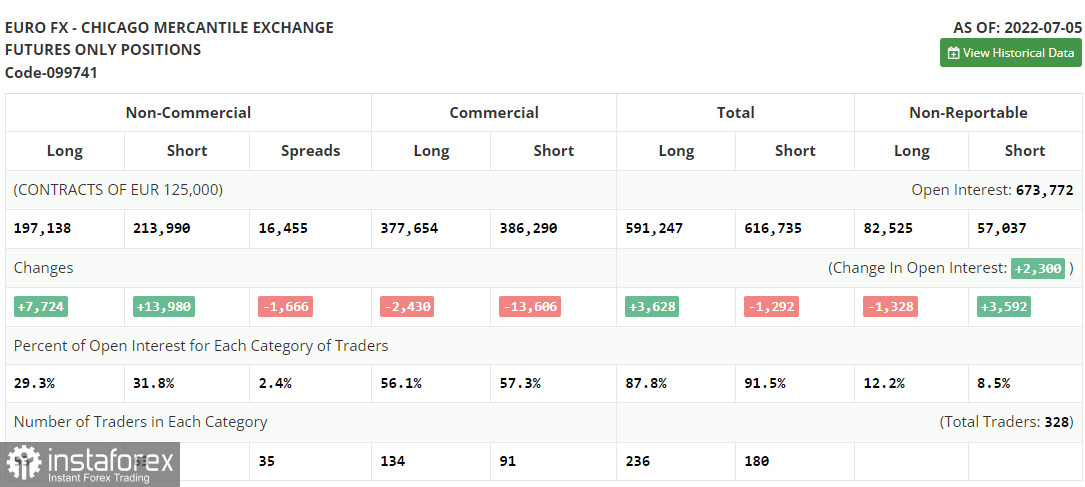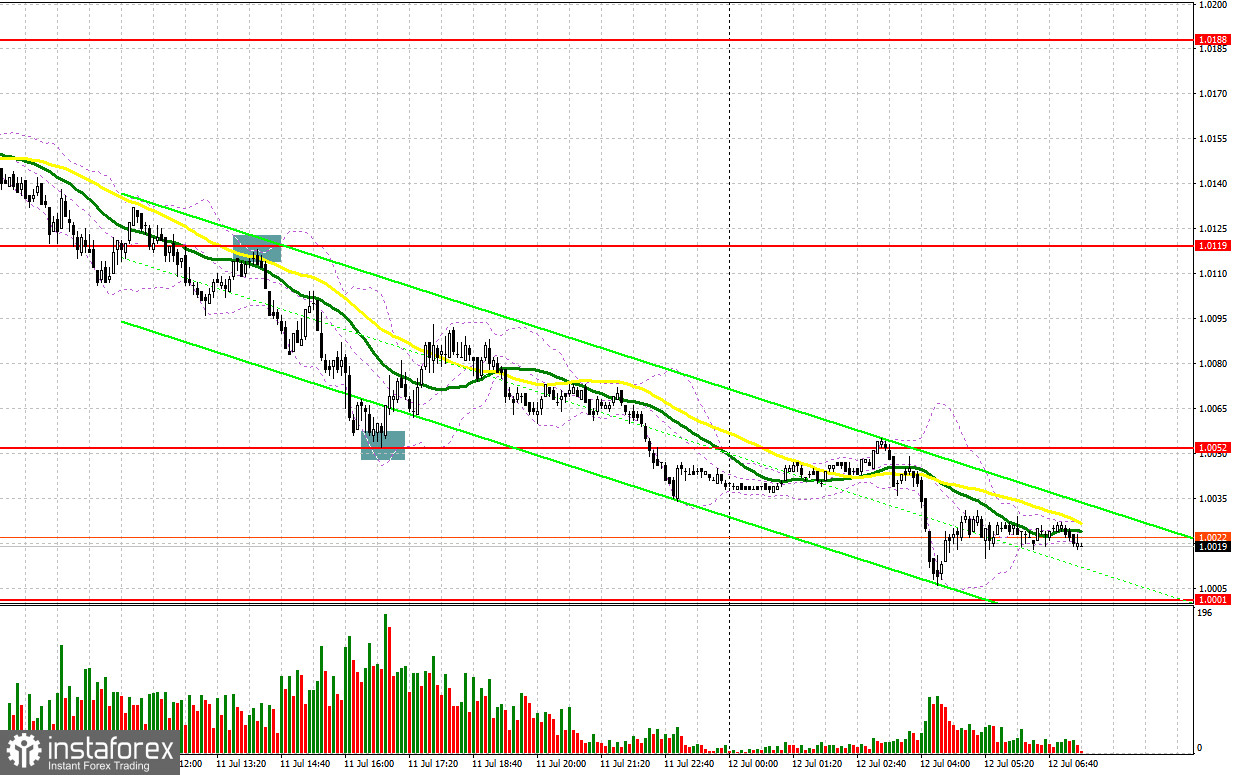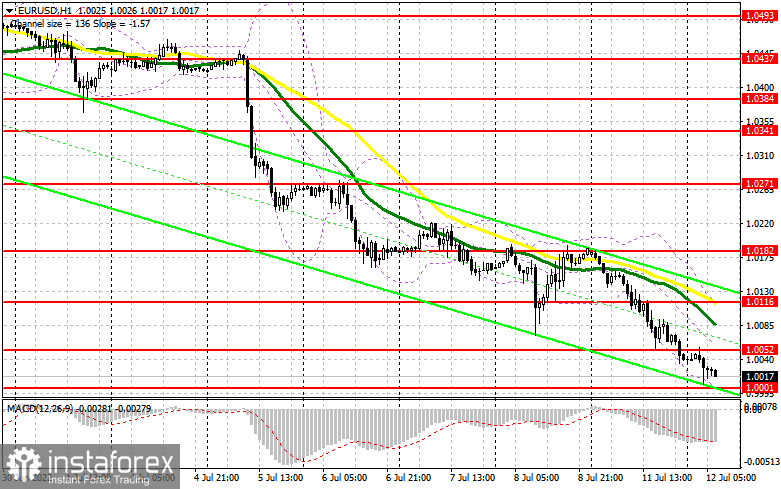When to go long on EUR/USD:
Several market entry signals were formed yesterday. I suggest you take a look at the 5-minute chart and figure out what happened. I paid attention to the 1.0119 level in my morning forecast and advised you to make decisions on entering the market. The decline to 1.0119 was quite expected, but we did not get a convenient entry point from there to the market: trading was constantly carried out either above or below this level. After an unsuccessful attempt to return above 1.0119 in the afternoon, a false breakout and a sell signal were formed. As a result, the pressure on the pair increased, which caused the euro to fall further along the trend towards 1.0052. A test of this level provided an excellent buy signal with a move up almost 40 points.

COT report:
Before talking about the further prospects for the EUR/USD movement, let's look at what happened in the futures market and how the Commitment of Traders positions have changed. The Commitment of Traders (COT) report for July 5 logged an increase in both long and short positions, but the latter turned out to be almost twice as large, which indicates that the bearish mood in the market remains. This resulted in forming a larger negative delta. Eurozone retail sales disappointed last week, while US labor market data, on the contrary, pointed to the need to continue to maintain the over-aggressive monetary policy by the Federal Reserve if they are serious about fighting high inflation. European Central Bank President Christine Lagarde also spoke and talked a lot about the need to start raising interest rates all with the same goal. A rather important inflation report in the US is expected in the near future, which may once again point to another jump in price growth. If this happens, you will not be surprised at the dollar's further growth against the euro and the achievement of parity for this instrument. The COT report found that long non-commercial positions rose 7,724 to 197,138, while short non-commercial positions rose 13,980 to 213,990. In many developed countries - all this continues to push for long positions on the dollar. At the end of the week, the total non-commercial net position remained negative and amounted to -16,852 against -10,596. The weekly closing price dropped and amounted to 1.0316 against 1.0584.

The pressure on the euro remains quite high, especially ahead of the US inflation report, which is expected in the middle of this week. The likelihood of further rate hikes in the US and continued aggressive policy, as well as a rapid slowdown in developed countries, continue to affect buyers of risky assets. Today in the first half of the day, only reports on Germany will be able to stop the euro's fall: the index of current economic conditions and the index of economic sentiment from ZEW for Germany and the eurozone can temporarily support EUR/USD, but on condition that the data turns out to be better than economists' forecasts. Given that nothing good is expected on these indicators, most likely bulls will have to defend the immediate support of 1.0001 more aggressively. If this level is updated after forming a false breakout, you can count on some upward correction.
The next target will be the resistance at 1.0052, which the bulls missed in yesterday's US session. A breakthrough and test to the downside of this range would hit the bears' stops, giving a signal to enter long positions with the possibility of a bigger upward trend towards 1.0116, where the moving averages play on the bears' side are. The bears will try to build the upper boundary of the descending channel in that area. A more distant target will be the area of 1.0182, where I recommend taking profits.
In case EUR/USD falls and there are no bulls at 1.0001, which is more likely, the pressure on the euro will seriously increase again. In this case, I advise you not to rush to enter the market: the best option for opening long positions would be a false breakout around 0.9958. I advise you to buy EUR/USD immediately on a rebound only from the level of 0.9915, or even lower - in the region of 0.9886, counting on an upward correction of 30-35 points within the day.
When to go short on EUR/USD:
As long as trading is conducted below 1.0052, everyone will count on the euro's succeeding decline against the US dollar. As I wrote above, only good data on the eurozone retains hope for a rebound in the euro, but I have a number of doubts about this. In case EUR/USD grows in the first half of the day after the reports are released, forming a false breakout near the nearest resistance of 1.0052 creates a signal to open short positions with the prospect of a further decline in EUR/USD and a return to support at 1.0001, which is the last "stop" before breaking the parity of the euro against the dollar. A breakthrough and consolidation below this range, as well as a reverse test from the bottom up by analogy with what I analyzed above - all this will lead to another sell signal with the removal of bulls' stops and a larger movement of the pair down to the 0.9958 area. A breakthrough and consolidation below is a direct road to 0.9915, where I recommend completely leaving short positions. A more distant target will be the area of 0.9886.
In case EUR/USD moves up during the European session, as well as the absence of bears at 1.0052, I advise you to hold back from short positions until the more attractive resistance of 1.0116 comes around, where the moving averages pass. A rebound down from this level will be provided even amid the closure of long positions by speculators. Forming a false breakout at 1.0116 could be a new starting point for the continuation of the bear market. You can sell EUR/USD immediately on a rebound from the high of 1.0182, or even higher - in the area of 1.0271, counting on a downward correction of 30-35 points.

Indicator signals:
Moving averages
Trading is below 30 and 50 moving averages, which indicates a continuation of the bearish trend.
Note: The period and prices of moving averages are considered by the author on the H1 hourly chart and differs from the general definition of the classic daily moving averages on the daily D1 chart.
Bollinger Bands
A breakthrough of the lower border of the indicator in the area of 1.0001 will lead to a fall in the euro. A breakthrough of the upper border of the indicator in the area of 1.0116 will lead to an increase in the euro.
Description of indicators
- Moving average (moving average, determines the current trend by smoothing out volatility and noise). Period 50. It is marked in yellow on the chart.
- Moving average (moving average, determines the current trend by smoothing out volatility and noise). Period 30. It is marked in green on the chart.
- MACD indicator (Moving Average Convergence/Divergence — convergence/divergence of moving averages) Quick EMA period 12. Slow EMA period to 26. SMA period 9
- Bollinger Bands (Bollinger Bands). Period 20
- Non-commercial speculative traders, such as individual traders, hedge funds, and large institutions that use the futures market for speculative purposes and meet certain requirements.
- Long non-commercial positions represent the total long open position of non-commercial traders.
- Short non-commercial positions represent the total short open position of non-commercial traders.
- Total non-commercial net position is the difference between short and long positions of non-commercial traders.





















